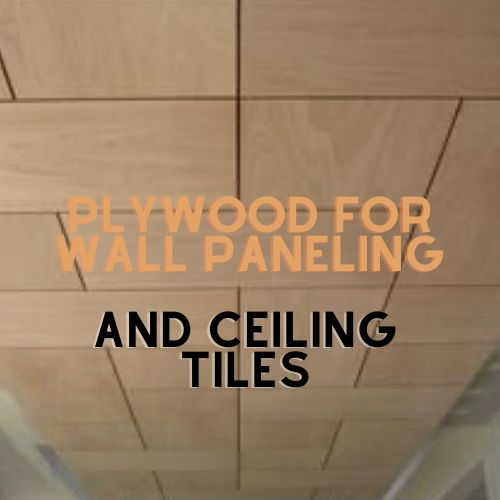Plywood is a versatile building material that has found an array of applications in construction, one of which is wall paneling and ceiling tiles. In this comprehensive guide, we’ll delve into the world of plywood for wall paneling and ceiling tiles. We’ll explore the various uses, benefits, and how this material can transform your interior spaces. Plus, we’ll answer frequently asked questions and provide you with valuable insights to help you make the right choices for your projects.

Table of Contents
- What is Plywood?
- Wall Paneling with Plywood
- Ceiling Tiles Made from Plywood
- The Benefits of Using Plywood for Walls and Ceilings
- Long-Tail Queries: Addressing Your Concerns
- Conclusion
1. What is Plywood?
Plywood is a composite material made by gluing together several layers, or plies, of thin wood veneers. These plies are stacked perpendicular to each other, providing plywood with strength, stability, and durability. The exterior layer, or face veneer, is often made of high-quality wood, making it an ideal surface for decorative applications like wall paneling and ceiling tiles.
2. Wall Paneling with Plywood
2.1. Decorative Wall Paneling
Plywood’s smooth and versatile surface makes it a perfect choice for decorative wall paneling. Whether you’re aiming for a modern, rustic, or classic look, plywood can be tailored to your desired aesthetic. It provides a clean canvas for paints, stains, or veneers, allowing you to create a unique interior design.
2.2. Plywood Shiplap
Shiplap is a popular wall paneling style characterized by horizontal, overlapping wooden boards. Plywood shiplap is cost-effective and easy to install, making it a preferred choice for DIY enthusiasts. It can instantly add character and warmth to your interior spaces.
2.3. Plywood Wainscoting
Wainscoting involves installing wooden panels on the lower half of the wall, adding a touch of elegance to your room. Plywood wainscoting is a cost-effective alternative to solid wood and can be customized to your preferred design.
3. Ceiling Tiles Made from Plywood
3.1. Plywood Ceiling Panels
Ceiling panels made from plywood offer an excellent solution for concealing imperfections and providing insulation. They are lightweight, easy to install, and come in various finishes, enabling you to enhance the visual appeal of your ceiling while improving its functionality.
3.2. Drop Ceiling Tiles
Plywood drop ceiling tiles are a popular choice in commercial and residential settings. They are easy to maintain, provide acoustic insulation, and can be customized to match the overall theme of your space.
4. The Benefits of Using Plywood for Walls and Ceilings
4.1. Strength and Durability
Plywood is renowned for its strength and durability. It can withstand the test of time, making it a reliable choice for wall paneling and ceiling tiles. Its multi-layered construction resists warping and cracking, ensuring longevity.
4.2. Versatility
Plywood is a versatile material that can be customized to suit your specific needs. It can be cut into various shapes, stained, painted, or veneered, allowing you to achieve your desired aesthetic.
4.3. Cost-Effective
Compared to solid wood or other building materials, plywood is budget-friendly. It offers a high-end look without the associated high costs, making it an excellent choice for those on a budget.
4.4. Easy Installation
Plywood is easy to work with and install. Its lightweight nature simplifies the installation process, making it suitable for DIY projects.
4.5. Sustainability
Many plywood products are sourced from sustainable forestry practices, making them an eco-friendly choice. Look for certifications like FSC to ensure you’re using responsibly harvested wood.
5. Long-Tail Queries: Addressing Your Concerns
5.1. Is plywood suitable for bathroom wall paneling?
Yes, plywood can be used in bathrooms when properly sealed. Water-resistant plywood is available, ensuring that your bathroom wall paneling remains durable in humid environments.
5.2. Can plywood be used for soundproofing?
Plywood can provide some degree of soundproofing. To enhance its acoustic properties, consider adding insulation materials behind the plywood panels.
5.3. Are plywood ceiling tiles easy to clean?
Plywood ceiling tiles are easy to clean and maintain. Regular dusting and occasional wiping with a damp cloth will keep them looking fresh.
5.4. How is plywood for wall paneling different from drywall?
Plywood is a more durable and versatile option compared to drywall. It offers better resistance to damage and can be customized to achieve various styles.
5.5. Can I paint plywood ceiling tiles?
Absolutely. Plywood ceiling tiles can be painted to match your interior décor. Make sure to prepare the surface properly and choose the appropriate paint for the desired finish.
6. Conclusion
Plywood for wall paneling and ceiling tiles is a game-changer in interior design. Its strength, versatility, cost-effectiveness, and sustainability make it a top choice for creating beautiful and functional spaces. Whether you’re looking to renovate a room, add character to your home, or improve insulation, plywood offers a plethora of benefits. With its myriad of applications and customizable options, plywood allows you to bring your creative vision to life. So, go ahead and explore the possibilities of using plywood for your wall and ceiling projects, and transform your space into a work of art.
Not Sure What Are You Looking At? Check the below guides:
Plywood for Cabinetry and Woodworking
The History of Plywood
